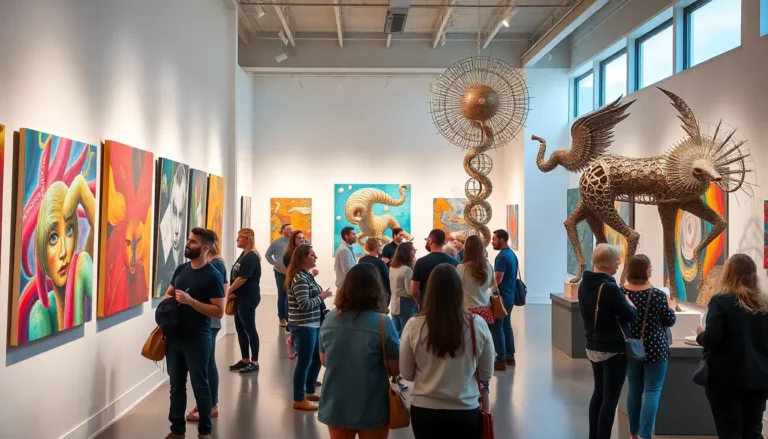Table of Contents
ToggleHead sculptures have a way of turning heads—pun intended! From ancient civilizations to modern art galleries, these striking pieces capture the essence of humanity in a way that’s both intriguing and a bit quirky. Imagine walking into a room filled with lifelike busts and abstract forms, each one silently telling a story. It’s like a party where the guests are all deep in thought, and you just can’t help but eavesdrop.
Overview of Head Sculpture
Head sculptures capture human form and emotion, serving as significant art pieces throughout history. Ancient civilizations crafted these artworks to honor deities, rulers, and ancestors, showcasing intricate details that reveal cultural values. Roman and Greek cultures, for instance, excelled in creating lifelike busts that conveyed power and intellect.
Numerous art movements embraced head sculpture, from Renaissance realism to modern abstract expressions. Contemporary artists experiment with various materials, including bronze, marble, and even recycled objects. These sculptures provoke thought by reflecting societal issues and personal identity, often challenging traditional norms.
Stylistic variation plays a crucial role in head sculpture. Realistic depictions emphasize anatomical precision, whereas abstract forms focus on emotional resonance. Different artists adopt unique techniques, allowing personal expression to emerge in each work.
Locations that house head sculptures include museums, galleries, and public spaces. Iconic pieces, such as Michelangelo’s David or the enigmatic busts of Nefertiti, draw thousands of visitors annually. Their allure lies not just in craftsmanship but also in the stories they encapsulate, allowing viewers to connect with history and humanity.
Art collectors frequently seek head sculptures for their aesthetic and historical value. Collectors appreciate how these artworks can evoke strong feelings and provoke dialogue. Auctions often feature head sculptures, with some pieces fetching millions due to their rarity and significance in the art world.
In essence, head sculptures represent a captivating intersection of art and history. They invite individuals to explore the depths of human experience, offering a glimpse into the diverse narratives that shape our understanding of existence.
Historical Significance of Head Sculpture
Head sculptures carry substantial historical importance, showcasing cultural values and societal beliefs.
Ancient Cultures
Ancient cultures utilized head sculptures to honor deities, leaders, and ancestors. Egyptians created ornate busts that celebrated pharaohs, evident in the stunning likeness of the bust of Nefertiti. The Greeks excelled in depicting idealized human forms, highlighting athleticism and beauty in marble busts. Romans contributed to this tradition by crafting realistic representations that emphasized individuality and status. Often, these sculptures served religious or political purposes, reinforcing the power dynamics of their time. Such works remain significant artifacts reflecting the ethos of those civilizations and providing insight into their social structures.
Influential Artists
Influential artists shaped the evolution of head sculpture throughout history. Michelangelo’s work, particularly the stunning David, revolutionized the representation of the human form. His emphasis on anatomical accuracy set new standards in sculpture. Other artists, like Auguste Rodin, pushed boundaries, focusing on emotional expression rather than realism. Contemporary figures, such as Takashi Murakami, merge traditional techniques with modern themes, creating unique pieces that reflect current societal issues. Each artist’s contributions have enriched the narrative of head sculpture, demonstrating its capacity to evolve while remaining rooted in historical significance.
Techniques in Creating Head Sculpture
Creating head sculptures involves careful consideration of materials and methods. Artists choose specific materials for their durability and aesthetic appeal.
Materials Used
Common materials in head sculpture include marble, bronze, clay, and wood. Marble offers a classic choice due to its elegance and resistance to weathering. Bronze, favored for its strength, allows for intricate details and patinas. Clay serves as a versatile medium for modeling and can capture fine textures. Wood, while less traditional, introduces warmth and organic qualities that resonate with audiences. Modern artists also experiment with recycled materials, reflecting contemporary themes and environmental concerns.
Methods of Carving
Carving techniques vary widely, emphasizing skill and intention. Traditional chiseling methods enable the crafting of detailed features in stone. Tools like rasps and files facilitate smoothing surfaces and refining shapes. In contrast, modern sculptors often embrace additive techniques, building forms with clay or mixed media. Techniques such as casting allow reproducing sculptures and expanding artistic reach. Digital modeling increasingly plays a role, blending classical techniques with modern technology, thereby transforming the creative process and expanding possibilities.
Contemporary Head Sculpture
Contemporary head sculpture reflects diverse perspectives and innovative techniques in the art world. Artists today challenge traditional norms, creating evocative representations of the human spirit.
Modern Artists and Movements
Modern artists redefine head sculpture through varied styles and materials. Ai Weiwei incorporates social commentary into his works, using head figures to provoke thought around political issues. Yoko Ono blends conceptual art with head forms, inviting viewers to engage with the piece on a personal level. Contemporary movements like Post-Internet Art encourage dialogue about digital culture and identity. Artists merge classical techniques with contemporary motifs, demonstrating the evolving nature of head sculpture. Each piece often carries a narrative that resonates with current societal themes.
Public Installations and Exhibitions
Head sculptures increasingly appear in public spaces, enhancing urban landscapes and community engagement. Large-scale installations by artists like Marc Quinn and Damien Hirst attract significant attention, inviting passersby to connect with art in their daily lives. Outdoor exhibitions provide visibility and accessibility, breaking down barriers inhibiting art appreciation. Museums host specialized exhibits featuring both historical and contemporary pieces, effectively showcasing their evolution. Major art fairs also celebrate head sculpture, drawing collectors and enthusiasts alike. These installations stimulate conversations around the relevance and impact of figurative art in today’s society.
Head sculptures continue to resonate deeply within the art world and beyond. They serve as timeless reflections of humanity’s complexities and cultural narratives. Each piece invites viewers to engage with the emotions and stories embedded within the materials and forms.
As artists push boundaries and explore new techniques, head sculptures evolve while maintaining their significance. They challenge perceptions and encourage dialogue about identity and existence in contemporary society. Whether displayed in galleries or public spaces, these artworks foster connections and inspire curiosity.
Ultimately, head sculptures remain a vital part of artistic expression, bridging the past and present while celebrating the rich tapestry of human experience.







